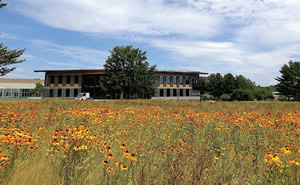A Living Building
- By Michael Medeiros
- 09/01/16

PHOTOS COURTESY OF HAMPSHIRE COLLEGE
In June, Hampshire College in Amherst, MA,
opened its new 17,000-square-foot campus center, the R.W.
Kern Center, as one of the greenest buildings in the world. The
college worked with architects from Bruner/Cott & Associates of
Cambridge, MA, to design a building that supplies its own water and
energy on-site, processes its own waste water, was built non-toxic to
avoid “Red List” chemical products and with materials mainly from
local and regional sources to limit the project’s carbon footprint.
Hampshire designed the building with the goal of becoming
one of only a dozen buildings worldwide certified under the most
advanced green building standard, the Living Building Challenge
(LBC). The standard aims to break society’s dependence on environmentally
harmful practices, to protect not only the environment but
also the workers who make the building materials, the tradespeople
who install them and the people who use the building. It aims to
compel improvements in the building and construction sector.
Aligning With Institutional Goals
The Kern Center, Hampshire’s first new major campus building in
nearly 30 years, is part of the college’s broad sustainability initiative and
its commitment to make campus operations carbon neutral by 2020.
The college is pursuing a related plan for its campus to go 100 percent
solar for its electricity this year, and arrays comprised of 15,000 solar
panels on 19 acres are currently being constructed on campus.
The Kern Center’s $10.4 million project cost was made possible
by private donations. It houses the offices of admissions and financial
aid, welcome areas, classrooms and social areas for students
and campus visitors, including a coffee bar. It was built as a living
laboratory designed to facilitate and inspire education for its lifetime
and was already being used during construction as the focus
of science, math, architecture and technology coursework.
The Living Building Challenge
The Living Building Challenge™ (LBC) from The International
Living Future Institute (ILFI) is a building certification program,
advocacy tool and philosophy that defines the most advanced
measure of sustainability in the built environment possible today. To support builders procuring for LBC
projects, the ILFI maintains a “Declare”
program (living-future.org/lbc)
that provides a platform for manufacturers
to disclose the chemical makeup of
each product and list their product in the
Declare public database.

PHOTOS COURTESY OF HAMPSHIRE COLLEGE
For the Kern Center, Hampshire committed
to avoiding the use of building
products containing any of a dozen toxic
Red List materials or chemicals including:
asbestos; chlorofluorocarbons; neoprene;
formaldehyde; hydrochlorofluorocarbons
(HCFCs); lead; mercury; polyvinyl chloride
(PVC) and wood treatments containing
creosote, arsenic or pentachlorophenol.
The Living Building Challenge restricts use
of products containing these chemicals because
of the risks they pose to humans and
the environment. The standard requires
each manufacturer disclose product ingredients,
and verify none are on the Red List.
In building the facility, the team was
required to find a source for each material;
verify materials were non-toxic, sustainable
and replenishable; and maintain supporting
documentation for certification.
It fell on the project team to reach out to
the manufacturers and in many cases even
communicate with product chemists to
document and verify ingredients.
More than 800 of the Kern Center’s
building products were vetted in this way,
six times the average for a construction
project this size. As a result of these efforts,
the facility will be one of the healthiest
buildings possible for people to work in
and visit, built with a relentless focus on
sustainability and stewardship. Hampshire
College President Jonathan Lash says, “It
is a physical embodiment of the college’s
values, a teaching tool in and of itself. This
building helps us see what is possible.”
Materials Procurement
To further promote stewardship, the
Kern Center building team aimed to procure
materials from sources in close radius
of the construction site, depending on their
weight, to reduce environmental impacts
from transporting products and to support
local economies.
To achieve LBC certification, all products
must be made using responsible industrial
practices for sustainable resource extraction
and fair labor practices. All wood was certified
by the Forest Stewardship Council (FSC)
or procured from salvaged sources, and the
chain of custody of the wood from stump to
project site was documented to negate the
possibility of counterfeiting.
Lastly, the LBC standard asks builders
to strive to reduce or eliminate construction
waste, and to conserve natural resources.
The building’s architects, Jason Forney
and Jason Jewhurst of Bruner/Cott, said in
a joint statement that the LBC challenges
architects and builders to stop focusing on
making buildings that are merely less bad,
and to ask instead, What does good look
like? “Good design starts with net positive
energy, net positive water, materials that are
safe for humans, designs that favor people
(not cars), healthy indoor environments and
innate connections to nature,” they said.
To complement the Kern Center,
Hampshire eliminated a long-standing
oval driveway from the middle of its main
quad and converted it back into a wildflower
meadow in order to bring nature and
pedestrians back to the center of campus,
and also stopped mowing 10 acres of lawn
to further reduce CO2 emissions. Hampshire
also permanently protected 46 acres of land
it owns on the Mount Holyoke Range.
This article originally appeared in the College Planning & Management September 2016 issue of Spaces4Learning.
About the Author
Michael Medeiros is a writer for Hampshire College as well as the Emily Dickinson Museum in Amherst, MA. A Massachusetts native, Medeiros recently edited A Mighty Room, a compilation of poetry by contemporary poets written in Emily Dickinson’s bedroom.